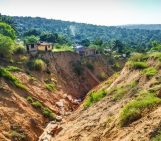
Iceland is a country of dramatically rugged landscapes. The region is home to sweeping valleys and mountain ranges, dotted with lava fields, large glaciers, hot springs and impressive waterfalls.
The territory is also notoriously treeless. As of 2016, forests only made up 1.9 percent of Iceland, according to the Icelandic Forest Service. However, about a thousand years ago the country’s landscape was far more vegetated, and remnants of Iceland’s original woodlands still exist today.
It is a common misconception that Iceland is too cold to sustain a forest. “On the contrary, it has been observed that, at the time of human settlement, birch woods and scrubs have covered large parts of Iceland,” said Marco Cavalli, a researcher at the Research Institute for Geo-Hydrological Protection in Italy and the photographer of today’s featured image. In fact, Iceland’s fossil evidence suggests that, before human settlement, 25-40 percent of the island was dominated by woodlands and thickets.
When humans migrated to the island about 1100 years ago, much of Iceland’s natural forests were chopped down to make way for fields and pastures. In the centuries following human settlement, intensive sheep grazing and volcanic eruptions prevented forests from regenerating. By 1950, less than one percent of the country was covered by trees.
Iceland’s vegetation-devoid state presents an environmental problem to local Icelanders, since the lack of trees, combined with the island’s volcanic activity, has left the land vulnerable to severe soil erosion. Since the soil conditions prevent vegetation from taking root, erosion has limited farming and grazing efforts. Iceland’s loose soil and strong winds are also responsible for damaging sandstorms.
Soil conservation and forestry services have made substantial efforts to repopulate the Icelandic environment with trees, just about doubling Iceland’s tree cover since the mid-20th century. However, there is still a long road ahead to reach the Icelandic Forest Service’s goal to see 12 percent of Iceland afforested by 2100.
This picture was taken by Cavalli while on a field trip in Rangárvellir, a southern region of Iceland near Gunnarsholt, the headquarters of the Soil Conservation Service of Iceland (SCSI). The workshop focused on the area’s severe degradation from both human activities and natural causes, and efforts to restore the ecosystem.
During the workshop he spotted this particular grove of dwarf birch trees. “I was impressed to see a small remnant patch of the Icelandic original birch forest resisting all these adverse conditions,” said Cavalli. “I would say this is a good example of nature fighting to survive.”
References
Forestry in a Treeless Land, Icelandic Forest Service
Changes in vegetation cover from the time of Iceland’s settlement, Icelandic Institute of Natural History
Vikings Razed the Forests. Can Iceland Regrow Them?, The New York Times
Imaggeo is the EGU’s online open access geosciences image repository. All geoscientists (and others) can submit their photographs and videos to this repository and, since it is open access, these images can be used for free by scientists for their presentations or publications, by educators and the general public, and some images can even be used freely for commercial purposes. Photographers also retain full rights of use, as Imaggeo images are licensed and distributed by the EGU under a Creative Commons licence. Submit your photos at http://imaggeo.egu.eu/upload/.




